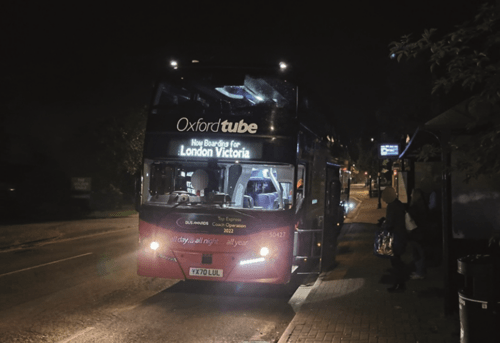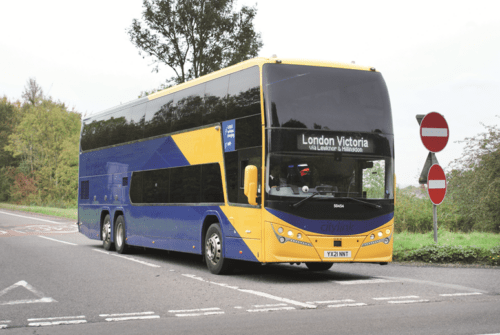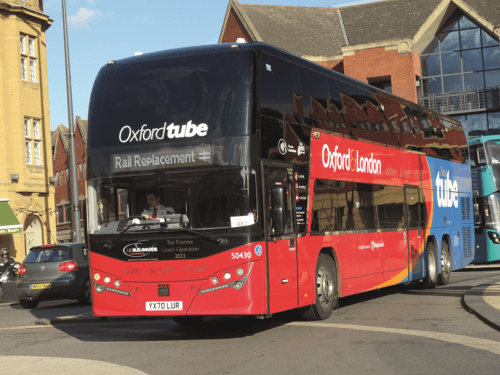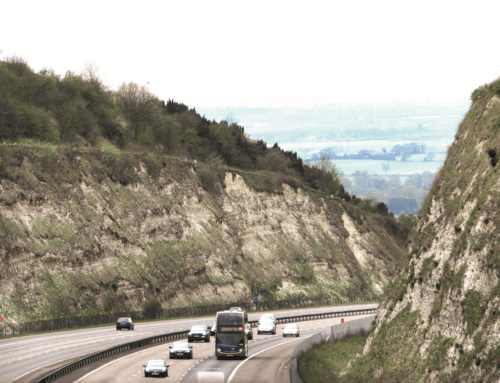
In mid October, Stagecoach West’s Oxford Tube service launched a significant expansion of its Oxford to London service, creating new links and providing enhanced frequency. Richard Sharman takes a look at the new developments, and has a look back at some of the brand’s previous operations outside of its core route
When you were the Gold Award winner at the UK Bus Awards in 2022, some might think that the job is done and you have proved that you are the top express coach operation. However, the Stagecoach West team behind the red and blue brand are not ones to be content and stop there; expanding the offering and serving new destinations is just part of a plan to go beyond beyond the M40 corridor.
Award winning times
If you have driven on the M40 between junctions 1 and 8, with such a high frequency, there is no doubt that you will have passed or seen one or more of the Tube’s fleet of Plaxton Panorama double-decker coaches with large stickers below the windscreen and below the rear window celebrating the fact the Oxford Tube won Gold at the UK Bus Awards in 2022.
It fought off tough competition from some of the UK’s best operators, with judges looking for an operation which ‘delights customers and which has successfully brought existing customers back since the pandemic, as well as attracting new customers.’ In addition, they sought evidence of high operational and customer service standards as well as effective marketing. The judges commented that Oxford Tube had adapted well to changed circumstances, and, with its high specification vehicles and good mystery traveller results, is ‘a service to be proud of.’
[wlm_nonmember][…]By subscribing you will benefit from:
- Operator & Supplier Profiles
- Face-to-Face Interviews
- Lastest News
- Test Drives and Reviews
- Legal Updates
- Route Focus
- Industry Insider Opinions
- Passenger Perspective
- Vehicle Launches
- and much more!
Of particular interest to the judges was:
- Despite ceasing operating during lockdown, the Oxford Tube overcame challenges and continues to deliver a high-quality, reliable coach service. Through continued investment in vehicles and technology its customer base grew from zero to 94% of pre-Covid passengers in just 16 months.
- The introduction of a new Oxford Tube app in March 2021, which provided enhanced journey planning and live coach tracking with estimated arrival times, as well as a wider choice of mobile tickets.
- Due to the successful return of 94% of its customer base, the Oxford Tube service improved its frequency with coaches running up to every 10 minutes, including more evening and weekend journeys added to meet demand.
- The success of the service, particularly evident during the recent rail strikes, transporting nearly 10,000 customers in just one day.
Rachel Geliamassi, Managing Director at Stagecoach West, explained: “Stagecoach is extremely proud to run the Oxford Tube service and to do so well at these prestigious awards is a huge honour. Our teams work incredibly hard to provide an excellent service and, with an operating rate of 99%, on a service that runs up to every 10 minutes, I think that’s something to celebrate.”

West Oxfordshire
Bus passengers using the Stagecoach bus network in Oxfordshire have always had the ability to purchase a Tube Connector ticket to travel into Oxford city centre and change onto an Oxford Tube service for the same price as a standard single or return ticket to London, with the bus journey being free.
Until now, commuters travelling from West Oxfordshire to the capital would do just that, by using the firm’s S1 or S2 services, but from 23 October that changed. Those commuters now have the opportunity of boarding the coach in the west of the county and travelling directly to London, avoiding having to travel via Oxford city centre, thus saving a significant amount of time each day.
Rob Hough, Operations Manager for the Oxford Tube, explained why West Oxfordshire was chosen for the service expansion: “We wanted to offer journeys on Oxford Tube to new areas, so we looked at where passengers were buying the Tube Connector ticket and we saw that West Oxfordshire was a popular area to travel from. We also know that quite a few passengers that use Oxford Tube travel to Thornhill P&R from a wide area of Oxfordshire and the Cotswolds as a park & ride service into central London, and we wanted to offer more journeys for those passengers.”
In the package of service enhancements which commenced on 23 October, passengers are now able to board ‘Tube’ services to London from a choice of four morning weekday departures from Carterton, Witney and Eynsham in West Oxfordshire.
Services depart from the first stop at Carterton at 0525, 0555, 0635 and 0805hrs before serving Broadshires and then travelling towards Witney, stopping at Minster Lovell. In Witney the route makes a number of stops on its way to join the A40. Once on the A40, the service stops at Cassington and Oxford North before running direct to Thornhill park & ride site, thereafter following the standard Oxford Tube route. Services arrive at London Victoria at 0815, 0910, 0950 and 1108hrs.
Three return journeys are provided from London Victoria at 1645, 1735 and 1830hrs, arriving back in Carterton at 1949, 2032 and 2113hrs. Commuters requiring earlier or later return journey can use the standard Oxford Tube service and change to the S1 or S2 service in Oxford as before.
The new journeys operate from Monday to Friday only, and exclude bank holidays. The new commuter route also passes the brand new park & ride site at Eynsham on the A40, which is due to open in 2024 and will have 850 parking spaces. It is hoped it will help improve congestion on the A40 and provide regular and reliable public transport services into Oxford and beyond; a new roundabout will make it easy to access from either direction on the A40.
Users will benefit from 24-hour security, dedicated cycle storage, public toilets and electric vehicle parking bays. Improved bus and cycle lanes on the A40 should also make coach and bus journeys quicker. The new London commuter route stopping here would be a huge benefit to the new site, it is claimed, and it is not something the Oxford Tube has ruled out, with Rob saying that once the new P&R site is open, he is sure the company will look to make use of it.
Also of note is that the Oxford North stop is right next to a huge science park being built between the A40 and A44, between Wolvercote and Pear Tree roundabout, so additional commuters could be gained there one the site is built. Given these factors, the new West Oxfordshire commuter route could have a bright future ahead.

Buckinghamshire connection
In a new departure for the coach operator, residents in High Wycombe will also be able to take advantage of the Oxford Tube service hourly on weekdays, with coaches departing from High Wycombe Coachway, before travelling to Hillingdon and continuing the journey via Baker Street to London Victoria. Located next to junction 4 of the M40, High Wycombe park & ride offers a convenient starting point for many passengers seeking a swift journey into London.
Rachel continued: “We’re delighted to be expanding the reach of our ever-popular Oxford Tube service to West Oxfordshire and High Wycombe, meaning even more passengers can travel into London easily, comfortably, sustainably and at a great price. Air-conditioning, super comfy seats, tables and charging points make our Oxford Tube an incredibly attractive option when travelling into London.
“High Wycombe is a brand-new catchment area for us so we look forward to welcoming some new faces on board, whilst our new stops in West Oxfordshire make daily commutes simpler for those currently having to make their way into the centre of Oxford to pick up the service. They can now start their journeys much closer to home.”
Rob added: “We have received requests to service High Wycombe Coachway and as always, we take on board our customers’ feedback when reviewing our schedules. There were also calls for more services to route into London via Baker Street hence the combining of both.
“Unfortunately, it’s unlikely that coach will ever be able to compete with the railway on journey times but it all depends on customers’ ultimate start and end points. If a customer’s destination is close to our route, then it is possible that we could compete on time once onward travel from a mainline station is considered. Our customer offer focuses on comfort, punctuality, reliability and price.”
Services from High Wycombe Coachway commence at 0659hrs and then follow an hourly frequency until 1101hrs, before recommencing again at 1400 until 1812hrs. From London Victoria, coaches depart at 0650 and hourly until 1002hrs, recommencing at 1205 until 1715hrs.
Moving on
As well as the new service variations, the main Oxford to London core service benefits with the frequency increased across the board; operating up to every eight to 12 minutes on a Saturday, 10 to 15 minutes Monday to Friday, and up to every 20 minutes into the night.
Tube Operations Manager Rob Hough explained: “People are travelling very differently now compared to pre-pandemic so we have stopped focusing on what happened in the past and focus now on offering what is right for the future. However, it is fair to say that we have seen most of the leisure market return but we certainly see fewer commuters on board. The ongoing rail disputes have also added to changes in demand, but we deal with those challenges when they come along and focus on our service delivery so that we can try to keep those passengers using Oxford Tube.
“The frequency increase that we implemented in June 2022 saw us return to service levels similar to those offered in 2019. That uplift focused on bolstering evening journeys as well as weekends. Over the past year, we recognise that we haven’t always had the required capacity at busy times and unfortunately have let some of our customers down by being unable to accommodate them. Whilst it is possible that some growth has come from customers switching from the train, I think that consumer confidence in public transport is returning and customers are beginning to make more journeys. The road to recovery from the Covid-19 pandemic is proving to be a long one and is seeing us have to respond to new travel patterns. The latest uplift utilises a peak vehicle requirement (PVR) of 26 coaches and has enabled us to not only increase our capacity at busy times but also gives us the opportunity to offer our great service to new markets in West Oxfordshire & High Wycombe.”

Rail strike day services
Whilst the wider Stagecoach West business is no stranger to providing rail replacement services throughout its operating area, it is a relatively new venture for the Oxford Tube unit. This year has seen Oxford be the focus of major work on the tracks in and around the city, with some of it being planned closures and a lengthy part of it being for an emergency track closures due to a viaduct abutment needing to be replaced at Nuneham. In addition Oxford railway station bridge has been shut since January, and will not now reopen until October 2024.
As well as providing replacement services between Didcot and Oxford, Oxford Tube coaches also saw use on a short rail replacement route in London during the summer.
Rob explained: “We have worked with Stagecoach Rail Replacement and First Travel Solutions to provide rail replacement over the past months. This was an opportunity that we explored as a result of having a reduced PVR during week days following the implementation of the June 2022 schedule. In addition to providing rail replacement services, the summer of discontent on the rail network has seen a large increase in customer numbers on strike days.
“It’s very much an all hands on deck approach. The whole team really pulls together as we look for staff to manage queues, sell tickets and obviously to drive. From an operations perspective, this relies on the goodwill of our drivers, who have been happy to help working extra shifts, and the expertise of our control team who manage the running of the operation. This is no easy task and relies on experience, flexibility and a willingness to put our customers first. It really is a huge team effort. I am very proud to have a team who puts so much focus on our customers and are often more than willing to assist when we know demand will be much higher than usual.”
Adapting to the changes
The Oxford Tube fleet has been evolving for some time since the Plaxton Panorama became the Stagecoach Group’s choice for double-decker coaches. Based on the Volvo B11RLE chassis with a Euro VI engine that develops 460hp, the initial fleet of 24 were delivered between November 2020 and February 2021, numbered 50421-50444.
These operated alongside a small number of Van Hool Astrogmegas. Last year three further Panoramas arrived that were delivered new to Stagecoach for work on the Scottish Citylink network and followed on from the Oxford Tube batch; these were 50446-8 and initially entered service in yellow and blue livery briefly before being painted into fleet colours.
In the last few weeks, further Panoramas have arrived from Scotland in the form of 50445 and 50452-4, with 50449 due in a few weeks time. Accordingly, the only Astromegas that remain in the fleet are 50272/4 which will stay whilst the Scottish Citylink liveried coaches go through a repaint programme.
Looking to the future, Rob told CBW: “We are very aware of our responsibilities regarding providing sustainable transport to our customers and the communities in which we serve and have invested heavily to provide Euro VI coaches in our last two fleet replacements. Personally, I think the future of coach will be hydrogen but that is my own opinion. I’m sure that we will look towards zero-emission vehicles when a viable option becomes available.”

History beyond the M40
This is not the first time Oxford Tube coaches have strayed further than the core route; in the early 1990s, when Leyland Tiger coaches formed the mainstay of the fleet, they could also be found operating through the Thames Valley to Heathrow Airport and London on service 390 which gained its own branding some time later. Ironically the service started in Witney when City of Oxford Motor Services was operating it many years prior to Thames Transit’s involvement. The vehicles were later upgraded to former Wallace Arnold Plaxton Paramount 3500 II-bodied Volvo B10Ms with 390 branding, initially on the original owner’s cream colour before gaining red and grey livery with Heathrow Tube and 390 branding, which included a large 727 jet image down the side. A few Ikarus Blue Danube coaches also gained this livery.
In 1995 the coaches were replaced with new Marshall-bodied Mercedes Benz minibuses in standard Thames Transit grey livery. But, this would not mark the end of the Tube serving Heathrow.
The coaches had their 390 branding removed, maintained their Heathrow Tube branding and 727 jet image and the Plaxtons gained additional lettering on the top windscreen reading Oxford-Heathrow-The World. The Ikarus coaches, which had larger destination display boxes, displayed service number 800.
The Heathrow Tube came about during the famed Oxford bus wars, and was short lived following an agreement by both of Oxford’s main operators to calm the situation in 2006 by withdrawing some of the competitive routes that were clogging up the city centre.
The next expansion beyond the M40 was a through service from London Victoria to Blenheim Palace and Stratford-upon-Avon via Oxford, branded ‘The Shakespearean.’ The service was operated by the world’s first low floor double-decker coaches, the pioneering Jonckheere Monaco-bodied MAN 24.350. This service operated between during 1999 and 2000.
The Oxford Tube also offered a direct coach service to the Millennium Dome, located on the Greenwich Peninsula in South East London, during all the hype that surrounded it in the year 2000.
In addition, for many years prior to the global pandemic, coaches were utilised on a Monday to Friday basis to provide extra capacity on Stagecoach’s S5 and S9 services in from Bicester and Wantage respectively. These journeys feature in the timetable booklets for those services, which noted that they were operated by Oxford Tube coaches.
Going Gold to London
Whilst the new West Oxfordshire route comes under the Oxford Tube brand, it is worth nothing that Thames Transit – the legal entity of the Oxfordshire depots in Stagecoach West – has linked Carterton and Witney to London in the past, but it was a not a service for commuters like the new offering.
Launched on 8 November 2014, Witney depot commenced operation of new leisure service SW1, aimed at day trippers, theatre-goers and shoppers. Operating on weekends and some bank holidays only, the service served Carterton and Witney, by-passed Oxford city centre and stopped at Thornhill park & ride before joining the M40.
Two departures operated in each direction, allowing the passengers from West Oxford flexibility. The first departure was at 0755hrs, with a second departing an hour later. Unlike the Oxford Tube, after Victoria, the SW1 continued to Westminster, Embankment station and Temple station before terminating at the Tower of London 2hrs 55mins after departure. Services returned at 1710hrs and 1810hrs, with vehicles being parked at Stagecoach London’s West Ham depot whilst laying over.
Same day returns were £18.00 with up to two children able to travel for free with a paying adult; the SW1 also allowed passengers to stay later in the day by catching a normal Oxford Tube service and then changing to an S1 or S2 local bus service to Witney or Carterton at Gloucester Green bus station. The service also provided additional capacity at Thornhill park & ride, with Oxford Tube singles and returns bought from a ticket seller, Tube 12, Tube passes 1 week or more and Tube Connector tickets accepted on the SW1 towards London.
Alexander Dennis Enviro400-bodied Scania N230UDs 15964-6 were the regular vehicles used and were purchased in May 2014 with three-point seatbelts and a digital tachograph added to their enhanced Gold specification to operate the service. The service was launched to initially attract Christmas shoppers and to test the market, and continued until April 2015.
Growing the brand
The Oxford Tube brand has been around since 1987, and in that time it has grown to be one of the most recognised express coach brands not just in the UK, but around the world, thanks to the vast number of international tourists that use it each year for a day out in Oxford or London. This expansion beyond its core route is something that may raise eyebrows in the industry, but it also shows Stagecoach West’s enthusiasm for the brand and its recognition that there are many more opportunities that can continue to help it grow and provide new links
for its customers.



